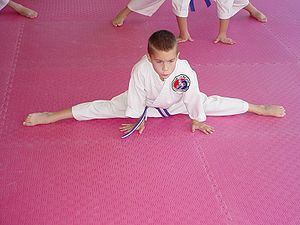Can you do “the splits?”
Splits are a topic on most young dancers’ minds. I know when I was a student the ability to sit in a split seemed pretty important. Of course, flexibility and range of motion are certainly fundamental elements in dance. However, when it comes to stretching and splits some dancers place intense emphasis on achieving the ideal static position, forgetting that this type of flexibility is only part of the picture. They compromise the healthof their instrument – the body – as they push to extremes to get results, and get results fast.
How fast is fast?
When it comes to stretching, “fast” is a very relative term. Online I’ve seen students inquiring how they might achieve a split over one weekend. Those offering branded stretching regimens that promise or imply fast results are usually talking weeks or months, but most correctly point out that results will vary depending on a number of factors.
What are these variables?
- Joint anatomy and physiology
- Elasticity of ligaments and tendons
- Gender – While a male has the same potential for flexibility as any female, differences in bone structure, muscle mass, and chemical make-up, often mean that women generally encounter fewer obstacles in achieving a certain level of flexibility or range of motion.
- Age – As with gender, the potential to perform a split is there no matter your age but flexibility declines in adulthood, meaning that maintaining or increasing the degree of pliancy requires more effort for an adult than a child.
- State of mind – Don’t write off the degree to which your mindset plays a part – science doesn’t. Discoveries and investigation continues to determine the brain’s role in stretching, and several flexibility programs directly address the issue.
As enticing as improving your flexibility over a period of a few days or weeks sounds, research tells us extreme stretching methods and overstretching can be counterproductive to gaining flexibility.
How?
A mechanism called the stretch reflex sends signals to a stretched muscle, causing it to contract in order to limit lengthening and protect the muscle from tears. Entering a split too swiftly or aggressively strengthens the contraction, working against gains in flexibility (this is one reason ballistic stretching or bouncing is discouraged). Instead, easing into and holding a stretch is recommended. This maintains the length in the muscle to a point that it “gets used to” the increased length and respond by reducing the level of the reflexive contraction.
So the longer, I hold it the better, right?
Actually, holding a stretch for very long periods of time (several minutes or longer) can cause damage to connective tissues, as does stretching without warming up the body. This damage requires time to repair and will actually slow progress in improving flexibility.
Are oversplits safe?
Nothing is inherently wrong with working toward oversplits… gradually, progressively, just as you would work at achieving other splits. However, I would suggest proceeding with even more awareness and care. See more on this in Oversplits… Overdoing It?
When Is the Right Time to Stretch?

I think it is pretty common knowledge among dancers these days that one should not stretch “cold.” However that habit of walking into a studio or green room and settling into our favorite stretch or straddle is a hard one to break. I’m guilty myself.
What you may not know is that there are different kinds or ways of stretching.
A split is considered a static passive stretch, meaning you are holding a stretch using your body weight or some other external force (as opposed to a static active stretch, like lifting your leg in arabesque, during which the stretch is held using the agonist muscles). Rather than warming up with static passive stretching, I would recommended that you begin with dynamic stretching, performing movements that address a joint’s full range of motion.
As dancer, your dynamic stretches may look like leg swings or variations of Bartenieff’s “X” series.
The best time for splits or other static passive stretches are after the body has been completely warmed up. After a class, for example.
What are some signals that I’m overstretching?
- If you’ve warmed up thoroughly and there is still pain, or
- If you experience muscle cramps or spasms, you may be stretching too aggressively.
- If you have pain during or immediately after the stretch, you may have a serious tear (you will usually feel some soreness from a minor tear the next day – if this occurs try to improve your warmup method). Tears usually result in some loss of flexibility. Light stretching can counteract this following a minor tear but be very careful not to overdo it.
- It may go without saying that if you hear a sound, like a pop, while stretching this is not a good sign. Stop immediately, follow the RICE method, and see a medical professional.
How Can I Get My Splits?

The answer isn’t exactly cut and dry. Everyone seems to have their own method and below I’ll point you to just some of the freely available and anatomically aware advice online. There are paid programs too but I can’t vouch for any of these because I’ve not tried them. Plus there are plenty of books on the subject. I welcome your thoughts on any programs or resources you’ve tried!
Splits and Flexibility Resources
- How to Improve Your Flexibility Safely Into the Splits – Lisa Howell (Lisa also has a Front Splits Fast program)
- Stretching and Flexibility – Brad Appleton
- Working Toward The Splits – Atlanta Martial Arts
- The Beginner’s Guide to Flexibility – Martial Arts Planet forum
Safe stretching is a huge topic with sometimes conflicting research. I couldn’t possibly cover it all in one or even two posts. The advice above, I hope, will help you determine if your current method or one you are exploring is a reasonably safe and healthy way to increase flexibility. Be wary of “too good to be true” claims and YouTube demonstrations from fellow students, please!
Nichelle Suzanne is a writer specializing in dance and online content. She is also a dance instructor with over 20 years experience teaching in dance studios, community programs, and colleges. She began Dance Advantage in 2008, equipped with a passion for movement education and an intuitive sense that a blog could bring dancers together. As a Houston-based dance writer, Nichelle covers dance performance for Dance Source Houston, Arts+Culture Texas, and other publications. She is a leader in social media within the dance community and has presented on blogging for dance organizations, including Dance/USA. Nichelle provides web consulting and writing services for dancers, dance schools and studios, and those beyond the dance world. Read Nichelle’s posts.

